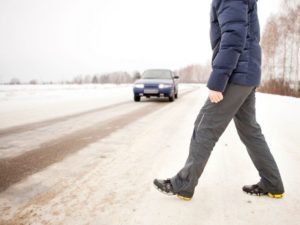
Let’s be honest: we’re all probably guilty of distracted walking. The smartphone alone has given Americans no shortage of diversions while walking. But is it contributing to more pedestrian accidents and deaths? The research is unclear.
There’s no question that distracted walking is dangerous. The National Safety Council reports that when people are walking and texting, they move slower, are more likely to make errors judging gaps in traffic, tend to make poor decisions, and are generally less aware of their surroundings. Yet the organization has also found that half of all distracted walking accidents occur at home, not on the roads.
In addition, a 2020 article in Streetsblog USA reports that studies have been unable to turn up “conclusive evidence that ‘distracted’ walkers are more likely to wander into roadways unaware, whether those distractions take the form of talking on phones, listening to music, texting, helping a child tie a shoe, or otherwise paying attention to anything besides their immediate surroundings.”
In the absence of concrete proof, many transportations officials and safety experts — including the Governors Highway Safety Association (GHSA) — agree that the troubling increase in pedestrian accidents is the result of placing more of the emphasis on pedestrian responsibility and less on outside factors, including:
- Distracted drivers
- Road design that has cars, not people, in mind
- Oversized SUVs
- High speed limits
- Intoxication
- The need for better law enforcement
Nationally, the GHSA found that pedestrian deaths increased 50 percent over the past 10 years. Data from the Michigan Office of Highway Safety Planning (OHSP) noted a 15 percent increase in pedestrian accidents in the last decade as well.
Furthermore, the latest available statistics from the Michigan Department of State Police show that 2,403 people were involved in pedestrian crashes in a recent year, resulting in 149 deaths and 1,910 injuries. Of the 149 people killed, nearly 76 percent had been drinking at the time of the collision.
What Can I Do to Prevent a Pedestrian Accident?
 Even with the conflicting evidence, both pedestrians and drivers have a duty to prevent traffic accidents.
Even with the conflicting evidence, both pedestrians and drivers have a duty to prevent traffic accidents.
Pedestrians can protect themselves by:
- Never walking while texting or talking on the phone.
- Never crossing the street while using an electronic device.
- Never walking or biking with headphones on.
- If you must text or talk, move over on the sidewalk and stop.
- Look left-right-left before crossing a street.
- Use sidewalks whenever available. If there are none, walk as far on the shoulder or curb as you can while facing traffic.
- Wear brightly colored or reflective clothing while walking, especially at night.
- Be especially cautious if walking while intoxicated. While walking is the better option compared to driving, it still puts pedestrians in a perilous situation.
Drivers can protect pedestrians by:
- Putting away other distractions behind the wheel.
- Enabling your smartphone’s “Do Not Disturb While Driving” function.
- Paying attention to their surroundings, especially in city traffic, at intersections, and in parking lots, work zones, and school zones.
- Obeying the speed limit at all times.
- Stopping for pedestrians at crosswalks.
- Obeying traffic signals.
- Looking carefully for pedestrians at night, when accidents are more likely to occur.
Contact Christensen Law if You’ve Been Hurt
Pedestrian accidents cause some of the most catastrophic harm. If you were injured on foot in Michigan, a trusted attorney at Christensen Law can help you seek maximum compensation for your damages. Put us to work for you. Call or contact us today for a free consultation.






